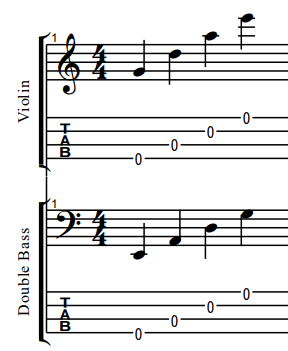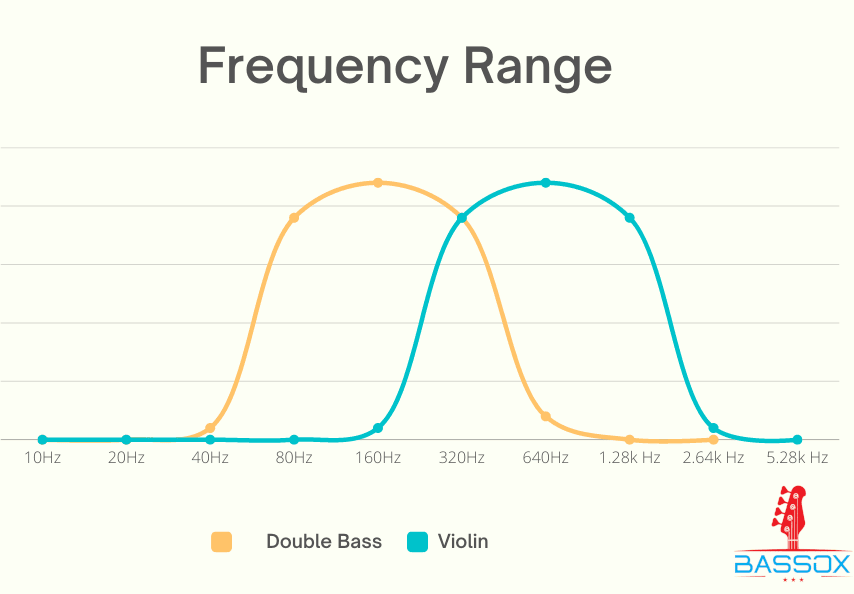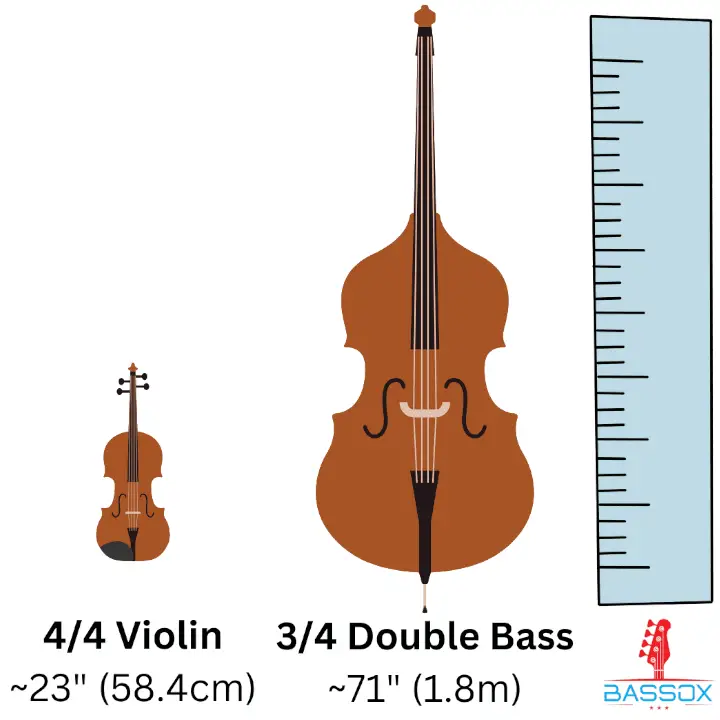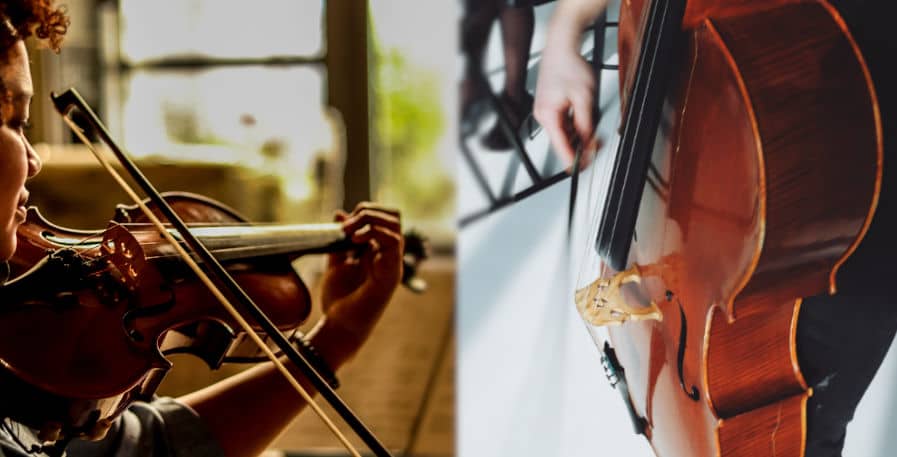Despite having many things in common, the double bass and violin also have a ton of differences.
They are both fretless 4-string instruments that are often used in the same genres of music. At the same time, they differ greatly in size and sound. They also fill vastly different musical roles.
Therefore, I have made this in-depth comparison of the violin and the double bass. I`ll cover every key difference between the two, and I`ll go more in-depth about their tuning, range, cost, size, difficulty, and purpose.
This will be useful for anyone who is considering picking up either of the instruments. It will also be helpful for anyone who is looking to develop their understanding of music or improve their composing abilities.
Key differences
To get a feel for the two instruments, let`s start with a brief side-by-side comparison of the violin and double bass.
| 3/4 Double Bass | 4/4 Violin | |
| Cost of cheapest available instrument: | ~500-700$ | ~100$ |
| Cost of decent entry-level instrument: | $1500+ | $1000+ |
| Cost of advanced instrument: | ~$4000+ | ~$3000+ |
| Weight: | ~25lb / ~ 11.3kg | ~1.1lb (~500grams) |
| Melodic Range: | E1-C5 | G3-E7 |
| Frequency Range: | 41.2Hz – 523Hz | 196Hz – 2637Hz |
| Scale Length / String Length: | 41″ – 43″ (104cm – 110cm) | 13″ (33cm) |
| Full length: | ~71″ (180cm) | ~23″ (58.4cm) |
| Tuning: | E-A-D-G | G-D-A-E |
| Role: | Doubles the cello an octave lower, or plays an independent deep groove. | Plays high melodies and main themes. |
| Played with: | A bow (Arco) or with fingers (Pizzicato) Playing with a bow is more common in orchestras, whereas pizzicato is more common in bands. | Acro (Mainly), Pizzicato (Occasionally) |
| First saw use | Early versions of the double bass were first used in the 15th century | First saw use in the 16th century |
| Difficulty | Medium | Hard |
| As a composing tool: | Limited and specialized in deep melodies | Limited and specialized in high melodies |
| As a solo instrument: | Decent, but less commonly used as such | Great, and commonly used as such |
Some of these points explain themselves, while others need a bit of elaboration. Thus, let`s dive deeper into some of the more impactful differences between the two instruments.
Tuning & Range
The standard tuning for double basses is E-A-D-G, whereas violins are tuned G-D-A-E.
This means that the strings on a double bass are tuned a perfect fourth apart. On a violin though, the strings are tuned a perfect fifth apart instead.
As a result, the two instruments require different finger positions. This also means that memorizing where notes are on the fingerboard of one of the instruments will not translate directly to the other.

Furthermore, while the instruments have a similar amount of range, they are played at vastly different pitches.
Between the bass, cello, viola, and violin, the bass is the lowest instrument, and the violin is the highest. The deepest string on a violin is a G3, whereas it is an E1 on the double bass. This means that the double bass is played at a range that is more than 2 octaves deeper than that of the violin.

As a result, you might enjoy one instrument over the other, depending on whether you prefer deep, resonant lines or high, sharp melodies.
Size
Another major difference between the violin and the double bass is the size of the two instruments.
A full-size violin is about 23″ long (58.4cm), whereas most double basses are more than 3 times as long at 71″ (1.8m).
The violin also comes in a range of sizes. For the most part, adults play 4/4 or 7/8 violins. 7/8s are about an inch (2.54cm) shorter than 4/4s. There also exist violins as small as 1/16, which are about 13 inches long (33cm), and intended for young violinists below the age of 5.
As for double basses, most adults play a 3/4 bass, while some larger adults play a 4/4. The 4/4 double bass is 77″ (1.95m) and thus noticeably larger than the more common 3/4. Like the violin, there are also basses as small as 1/4, which are 61″ (1.55m) and intended for younger musicians.

The double bass also weighs approximately 20 times as much as a violin does. Full-size basses tend to weigh about 25lb (~11.3kg), or a pound or two less. Violins generally weigh between 0.77lb and 1.32lb, or 350 to 600 grams.
The weight and size of the instruments also impact how the instruments are played.
Violins can effortlessly rest against the neck and shoulder of a violinist without feeling cumbersome. Double basses need to be anchored to the ground with an endpin and then held up against the body of the bassist. Both instruments can be played while seated, or while standing up.
Cost
You can find both entry-level basses and violins that are relatively affordable. However, they have a noticeable drop in quality from more costly hand-made instruments.
It`s also worth noting, that cheaper instruments are not necessarily beginner friendly. You can get started with them, but the poor build quality tends to make them harder to play for bassists and violinists of all skill levels.
A good-sounding beginner violin will thus generally cost at least $1000. This is the bare minimum you can expect to pay for a decent instrument, and even beginner violins can cost as much as $3000.
For double basses, expect to pay at least $1500 for a good beginner instrument. As with violins, costs can dramatically increase between models, so consider this price the bare minimum as well.
As for cheap instruments, you can find violins for as low as $100, and occasionally even cheaper. In this price range, double basses are a lot more expensive than violins, and the cheapest among them tend to cost about $600.
Note:
While beginner instruments can sometimes be found for cheaper when bought second-hand, this is rarely the case for violins and basses.
This is because these instruments rarely depreciate in value, which can make it hard to justify the risk of buying them second-hand. Poor second-hand instruments that have depreciated in value are also often in need of a setup, which will add to their cost.

Difficulty
Out of all instruments, the violin is one of the most difficult among them to learn.
The major reason for this is that making the instrument sound pleasant requires you to be incredibly precise.
Violinists need to apply the perfect amount of pressure when bowing strings, It is also a small instrument with a thin neck and short strings.
Since the neck is so thin, the strings are closely situated to one another on it. As a result, it requires a lot of precision to hold down the right strings and develop control of your hand.
The short length of the strings also makes it difficult to control the intonation and play the right notes. As the strings are shorter, tiny changes in where you hold a string down lead to noticeable changes in pitch.
As a result, it takes a lot of practice to hit notes perfectly, and small mistakes are unforgiving because they can ruin a melody instantly. Since bowing requires such precision, it will generally take months before you can play any form of melody on the violin at an adequate level.
The double bass poses some of the same challenges as the violin. All in all though, it is a moderately difficult instrument to learn and not as hard as the violin is.
Due to the length of the strings and the wider neck, it is easier to fret strings and small changes in pitch will not be as noticeable. Double bass parts are often also easier and slower than violin parts, and it will thus take a shorter amount of time before you can play real pieces of music.
Lastly, neither the violin nor the double bass has frets. Thus, you need to learn how to position your hands and handle intonation on both instruments. Therefore, if we compare the double bass to the bass guitar, the double bass is noticeably harder to play well.
In conclusion, the violin is significantly harder for beginners than the bass guitar. The double bass is also harder for beginners than the bass guitar. In turn, learning to play the violin well is harder than learning the double bass.
Role
The violin and the double bass fill vastly different roles in both bands and orchestras.
Violins are mainly used for playing melodies, due to the instrument being tuned to a high-frequency range. Because of this, it is easy to hear it among other instruments as it naturally layers itself on top of them. Thus, the violin often takes on a lead role in orchestras and bands.
On the other hand, double basses are used to provide deep layers and hits to an orchestra, due to the instrument being tuned at a low-frequency range. In bands, the bass generally plays groovy pizzicato basslines that tend to have more movement to them than in orchestras.
Thus, while not as discernable as the violin, the bass provides an essential supportive role in both orchestras and bands. The instrument gets its name from doubling the cello in this manner, and therefore there is no instrument called the single bass.
Without the violin, orchestras would lack upper melodies. This would result in pieces sounding bland and leave you waiting for something more to happen.
Without the double bass, orchestras lack low frequencies. The cellos would still serve as a fundament for the other instruments to build upon without it. However, an orchestra would sound thinner and less powerful without the double bass filling in the low end below the cellos.
In bands, the lack of a double bass is even noticeable. As bands commonly only have 1 bass, and no cellos to fill in the low-medium frequencies, the bass is paramount for preventing a band from sounding hollow and grooveless.
Conclusion
Despite looking alike and being played similarly, the violin and double bass are very different instruments.
If you are deciding between picking up either of the two instruments, I recommend considering the following:
- Do you want to play a big and heavy or a small and light instrument?
- Do you prefer a supportive or a lead role?
- Are you more drawn toward deep and resonant tones or sharp and high ones?
- Are you more drawn toward the layers and grooves in music, or do you prefer the melodies?
- Would you prefer an instrument that is moderately difficult or one that is very challenging to learn?
While there are other factors, the answers to these questions should give you a good idea of whether you will enjoy the double bass or violin the most.
As for composing music, understanding the difference between the roles of the bass and violin is very helpful.
By considering what roles the two instruments fill and why it becomes easier to write parts for both instruments that make use of their strengths. As a result, arrangements and songs will end up sounding more cohesive and fleshed out.
Thus, regardless of how you intend to use the information in this article, I hope it serves you well in your musical endeavors.

